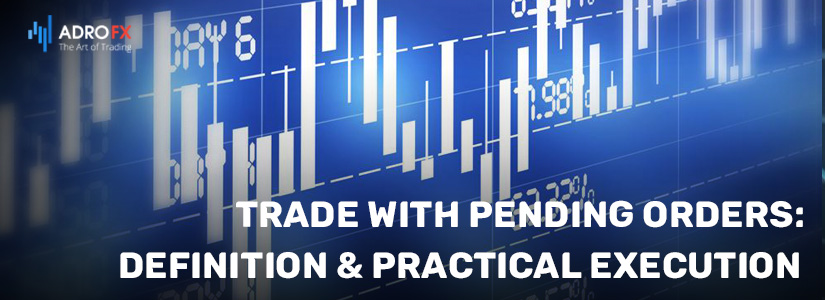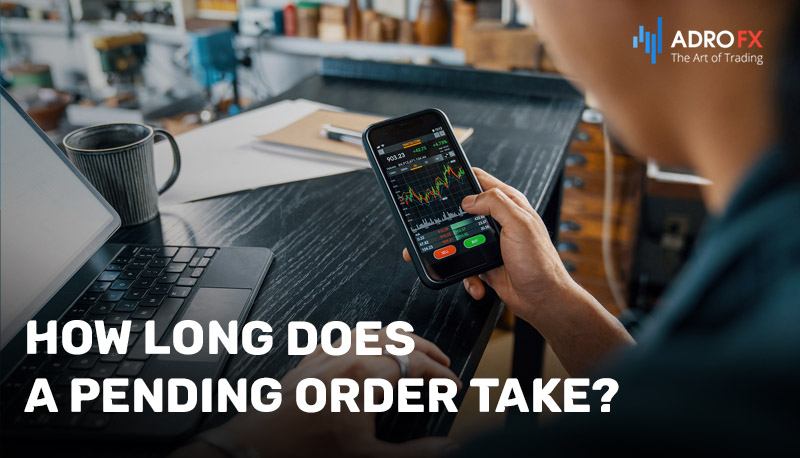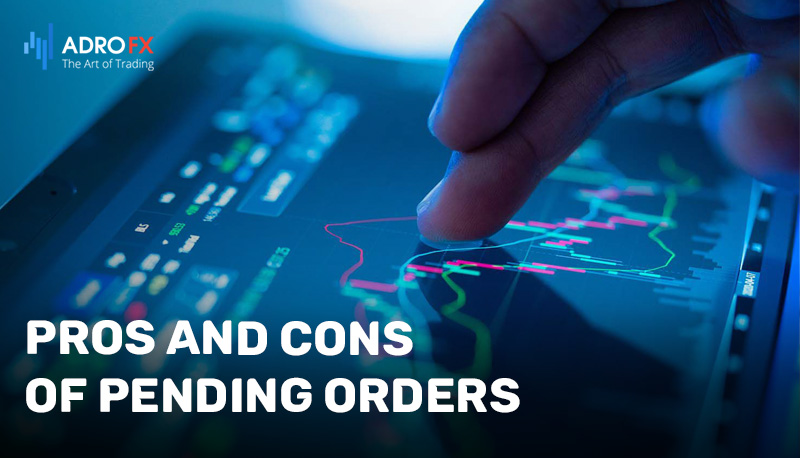Trade with Pending Orders: Definition & Practical Execution

Welcome to the world of financial markets, where precision and strategy are the keys to success. In the dynamic realm of trading, the ability to capitalize on market movements efficiently can make all the difference. One powerful tool that traders wield to navigate this landscape is the concept of "Pending Orders." These orders allow traders to predefine their entry and exit points, enabling them to enter or exit positions automatically when specific market conditions are met. In this article, we delve into the definition and practical execution of trading with pending orders. We will explore the various types of pending orders, dissect their mechanics, and uncover the strategic advantages they offer to traders. Whether you're a novice looking to enhance your trading skills or a seasoned professional seeking to refine your approach, understanding how to effectively use pending orders can significantly elevate your trading game. Join us as we unravel the intricacies of this essential trading technique and equip you with the knowledge to navigate the markets with greater precision and control.
What Are Pending Orders?
In the context of forex trading, "pending orders" refer to specific types of orders that traders place in advance to open positions at predetermined price levels. These orders are not immediately executed but are held in the trading platform until the market price reaches the specified level. Pending orders in forex trading help traders automate their strategies and take advantage of potential market movements without constantly monitoring the market.
There are several types of pending orders commonly used in forex trading:
- Buy Limit Order: A buy limit order is placed below the current market price. Traders use this order when they expect the price to drop to a certain level and then reverse and rise. It allows them to buy at a lower price.
- Sell Limit Order: A sell limit order is placed above the current market price. Traders use this order when they anticipate the price to rise to a certain level and then reverse and fall. It allows them to sell at a higher price.
- Buy Stop Order: A buy stop order is placed above the current market price. Traders use this order when they expect the price to break through a certain level and continue rising. It helps them enter a trade as the price gains momentum.
- Sell Stop Order: A sell stop order is placed below the current market price. Traders use this order when they anticipate the price to break through a certain level and continue falling. It helps them enter a trade as the price gains downward momentum.
- Buy Stop-Limit Order: This order combines features of both a buy stop and a buy limit order. It becomes a limit order once the specified stop price is reached. Traders use it to ensure they enter the trade after a certain price level is breached.
- Sell Stop-Limit Order: Similar to the buy stop-limit order, this combines the features of a sell stop and a sell limit order. It becomes a limit order once the specified stop price is reached, helping traders enter a trade after a certain price level is broken.
Pending orders are a crucial tool for forex traders to manage risk, execute specific trading strategies, and take advantage of potential market movements. They allow traders to predefine their entry and exit points, reducing the need for constant monitoring of the markets and providing more control over their trading activities.

How Long Does a Pending Order Take?
The time it takes for a pending order to be executed can vary widely based on several factors, including the type of order, market conditions, liquidity, and the specific trading platform or broker you are using. Here are some factors that can influence the time it takes for a pending order to be executed:
- Type of Order: Different types of pending orders (buy limit, sell limit, buy stop, sell stop, etc.) have different triggers for execution. Buy limit and sell limit orders require the market to reach a specific price level, while buy stop and sell stop orders trigger when the market moves through a certain price level. The time it takes for these conditions to be met can vary.
- Market Conditions: The speed of execution can be affected by the current volatility of the market. In highly volatile conditions, prices can move quickly, resulting in faster order execution. In calmer market conditions, it might take longer for prices to reach the desired levels.
- Liquidity: Highly liquid markets tend to have faster execution times because there are more buyers and sellers, making it easier to match orders quickly. Illiquid markets might experience delays in order execution due to a lack of available trades at the desired price levels.
- Broker's Technology: The efficiency of the trading platform and the broker's execution technology can impact the time it takes for a pending order to be executed. Brokers with faster and more reliable execution systems might process pending orders more quickly.
- Trading Hours: The time of day matters, as certain trading sessions are more active and have higher trading volumes. During active trading hours, pending orders are more likely to be executed quickly.
- News and Events: Important news releases or events can cause sudden spikes in volatility and impact the execution of pending orders. It's possible for orders to be executed more quickly or experience slippage during such events.
- Weekend and Holidays: Trading during weekends or holidays can lead to gaps between prices due to the market being closed. This can affect the execution of pending orders when the market reopens.
Due to the many variables involved, there is no fixed time frame for pending order execution. In some cases, pending orders might be executed within seconds, while in other cases, it might take several minutes or longer. To get a better idea of how long pending orders typically take to be executed on a specific trading platform or with a specific broker, it's recommended to refer to their order execution policies and consider any real-time market conditions that might affect execution times.
Pending Orders vs Market Orders
The question often arises: which is superior, pending orders or market orders, and which carries more advantages? The reality is that both order types come with their own merits and drawbacks.
Market orders possess a distinct advantage in that they guarantee execution. This certainty arises due to the ample liquidity prevalent in financial markets. On the other hand, pending orders come with the potential risk of non-execution, stemming from the necessity for the price to align precisely with the designated entry level.
Nonetheless, market orders are not without their downsides, with "slippage" emerging as a noteworthy concern. Slippage refers to instances where the price at which an order is initially placed differs from the actual execution price. For instance, initiating a buy trade at $10 may result in the broker executing it at $11. This phenomenon is most prevalent during periods characterized by heightened market volatility.

Pros and Cons of Pending Orders
Pending orders offer several advantages and disadvantages to traders, depending on their trading style, strategy, and market conditions. Let's explore the pros and cons of using pending orders:
Pros of Pending Orders
- Automation: Pending orders allow traders to automate their trading strategy by specifying entry and exit points in advance. This reduces the need for constant monitoring of the markets.
- Precise Entry: Traders can enter the market at specific price levels they believe are advantageous, helping them capture potential price movements more accurately.
- Control: Traders have better control over their trades with pending orders, as they can predefine their desired price levels and risk management parameters.
- Risk Management: Pending orders can be combined with stop-loss and take-profit levels to effectively manage risk and potential losses.
- Avoid Emotional Trading: Since pending orders are executed automatically, traders are less likely to make impulsive decisions based on emotions or short-term market fluctuations.
- Capture Breakouts: Certain pending orders, like buy stop and sell stop orders, are useful for capturing breakout moves when the price breaks through key levels of support or resistance.
Cons of Pending Orders
- Missed Opportunities: If market conditions change rapidly, pending orders may not be triggered, causing traders to miss out on potential trading opportunities.
- Slippage: When market volatility is high, pending orders might be executed at slightly different prices than intended due to slippage, potentially affecting profitability.
- No Immediate Execution: Pending orders do not guarantee immediate execution, as they rely on the market reaching the specified price level. This could lead to delays in entering or exiting trades.
- False Breakouts: Traders using pending orders to capture breakouts might experience false breakouts where the price briefly moves beyond the level before reversing, causing the order to be triggered and then resulting in a losing trade.
- Complex Strategies: Implementing complex trading strategies involving multiple pending orders can be challenging and may require a deep understanding of market dynamics.
- Market Gaps: Over weekends or during news events, the market can experience gaps between the closing and opening prices, potentially causing pending orders to be executed at unfavorable levels.
- Overdependence: Relying solely on pending orders without considering real-time market conditions can lead to poor decision-making, especially if the market behaves unexpectedly.
So, pending orders offer traders the advantage of automation, control, and precise entry points, but they also come with risks such as missed opportunities, slippage, and potential false breakouts. Traders need to carefully consider their trading strategy, risk tolerance, and market conditions when deciding whether to use pending orders. Combining pending orders with proper risk management techniques can help mitigate their disadvantages and enhance their benefits.
Conclusion
Entering the world of financial markets demands precision, strategy, and the skill to seize opportunities. In the dynamic realm of trading, success hinges on efficiently capitalizing on market movements. Among the array of tools at a trader's disposal, "Pending Orders" stand out as a powerful mechanism. These orders empower traders to predetermine entry and exit points, enabling automatic execution based on specific market conditions. In this article, we've delved into the intricacies of trading with pending orders, unraveling their types, mechanics, and strategic advantages. Whether you're a newcomer seeking to sharpen your trading acumen or a seasoned practitioner refining your approach, a comprehensive understanding of pending orders can elevate your trading endeavors significantly. As we've explored this essential trading technique, we've equipped you with insights to navigate markets with heightened precision and control, making your trading journey more rewarding and informed. Welcome to the world of pending orders, where strategy meets execution for a more empowered trading experience.

About AdroFx
Established in 2018, AdroFx is known for its high technology and its ability to deliver high-quality brokerage services in more than 200 countries around the world. AdroFx makes every effort to keep its customers satisfied and to meet all the trading needs of any trader. With the five types of trading accounts, we have all it takes to fit any traders` needs and styles. The company provides access to 115+ trading instruments, including currencies, metals, stocks, and cryptocurrencies, which make it possible to make the most out of trading on the financial markets. Considering all the above, AdroFx is the perfect variant for anyone who doesn't settle for less than the best.









